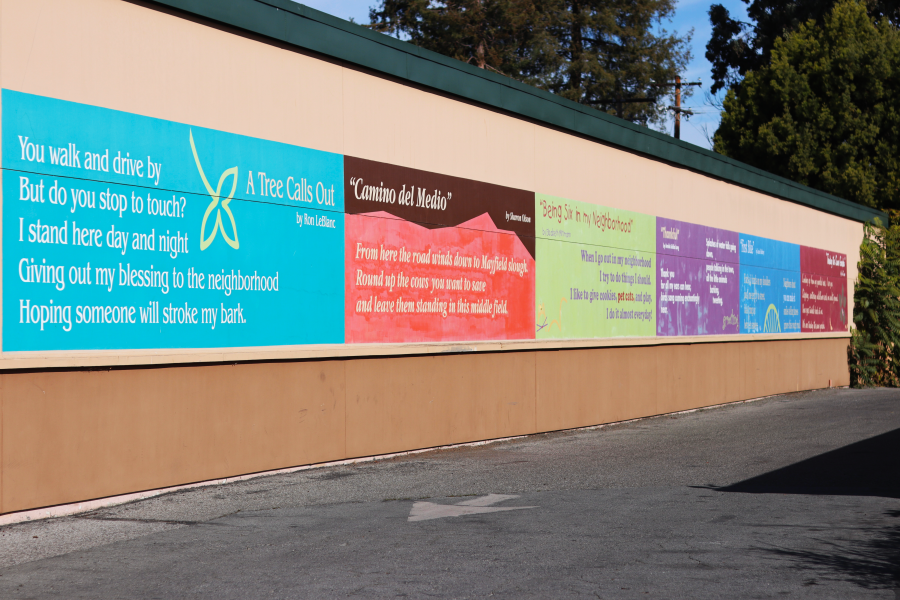The Public Art Commission voted on Nov. 17 to reproduce the deteriorating Midtown Poetry Wall as a temporary installation painted on aluminum panels. These panels have a projected lifespan of two to three years.
Public Art Program Director Elise DeMarzo said the mural on the exterior wall of the Walgreens building at the Midtown Shopping Center is in need of repair because of the paint’s poor condition. She said the six painted murals, featuring five second-place and one first-place winner in a 2003 “Writing on the wall” poetry contest, have deteriorated because of the wall’s south-facing orientation which is often exposed to damaging sunlight.
“It appears that the majority of the problem was with the lower layers of the paint trapping moisture and bubbling,” DeMarzo said. “That wall is really challenging for any mural because there’s absolutely no shade or protection out there. So anything that’s done on that wall, especially on that kind of scale, for us to continue to maintain it in perpetuity, is going to be really expensive.”
In accordance with the Public Art Program’s Deaccession of Artwork Policy, DeMarzo said the wall’s unfeasible maintenance was a large factor in the commission’s decision to remove the poetry wall from the city’s permanent art collection in June.
However, Midtown Residents Association leader Annette Glanckopf, who opposes deaccession, said the mural has not been properly maintained because of the city’s inadequate budget for maintaining artwork and the way it’s unfairly distributed.
“They only have $30,000 a year to maintain all the artwork in the city,” Glanckopf said. “All the art funding is for downtown and for California Avenue. Every single one. They really have not funded anything in Midtown since 2015.”
Sharon Olson, one of the second-place winners who wrote “Camino del Medio,” which describes Midtown as a refuge, said the mural is especially important to Midtown residents because the area has less public art than other sections of Palo Alto.
Glanckopf said the lack of funding for art in Midtown also puts more responsibility on the Midtown Residents Association to advocate for new and existing artwork, including the poetry wall.
“The only time Midtown has ever gotten art, which is different (from) any other part of the city, the Midtown Residents Association has had to fight for every single art project we have,” Glanckopf said. “Midtown residents actually persuaded the building owners where Walgreens is to allow the public art on that building. Every single (art) project that has been done with Midtown, we have been a key member of whatever decision body there was to select the art.”
Olson said the poetry wall speaks to what Midtown residents treasure, a main reason why she said she is in favor of keeping the poetry wall long-term.
“It captures a period in Palo Alto history,” Olson said. “To have something of that nature still there and still protected, it shows a value for art. I think it’s a beautifully painted mural, all the different colors. It’s very striking to me.”
Glanckopf said the Midtown Residents Association received over 50 letters, most in favor of restoring the mural as a long-term installation, leading to the commission’s decision to either restore or replace the mural. She said these letters were a deciding factor in the commission’s decision to restore the poetry wall.
“The first time they voted, and it looked like they were going to vote that way again, was to remove the poetry wall totally and come up with some new idea, which no one wanted,” Glanckopf said. “I think (the letters were) the thing that changed their minds.”
Junior, artist and Midtown resident Sophia Lee said the quantity of these letters shows Palo Alto prioritizes community building and art a lot more than other places.
“It’s amazing that (residents) would go out of their way to advocate for something as simple as a poetry wall,” Lee said.
In addition to the poetry wall representing Palo Alto’s history and character, residents wrote letters to the Midtown Residents Association expressing ways the mural had shaped their lives.
“One lady said that she taught her child how to read from the mural,” Glanckopf said. “Some of the artists, especially the mothers of the little kids that did the work, talked about how meaningful it was for the kids and how it changed their life and their direction.”
Though Lee said she respects that the poetry wall represents Palo Alto’s history, she would also appreciate a different mural that brings people together in a new way.
“(A new mural) could give a fresh, new feeling to the wall and be something that younger generations can resonate with,” Lee said. “It would be a fun opportunity to get new voices on there, and I’m sure kids these days would have a lot of fun with it.”
DeMarzo said the commission hopes to provide this space for younger artists and community members when the temporary restoration of the poetry wall is up.
“I would love to do something new and dynamic there and get the Midtown community involved in working with the artist in the design and even the painting of the new mural (to) attract a renewed energy,” DeMarzo said. “It’s really wonderful that we have this partnership with the property owner and that they allow us to do this. So we want to make sure we maintain that relationship.”

